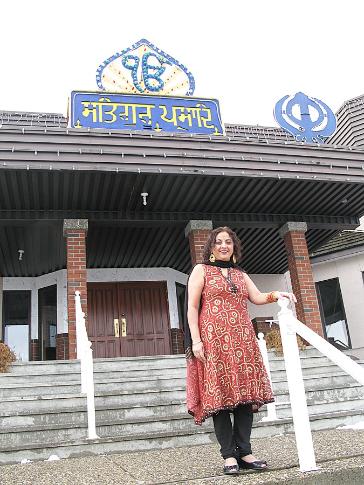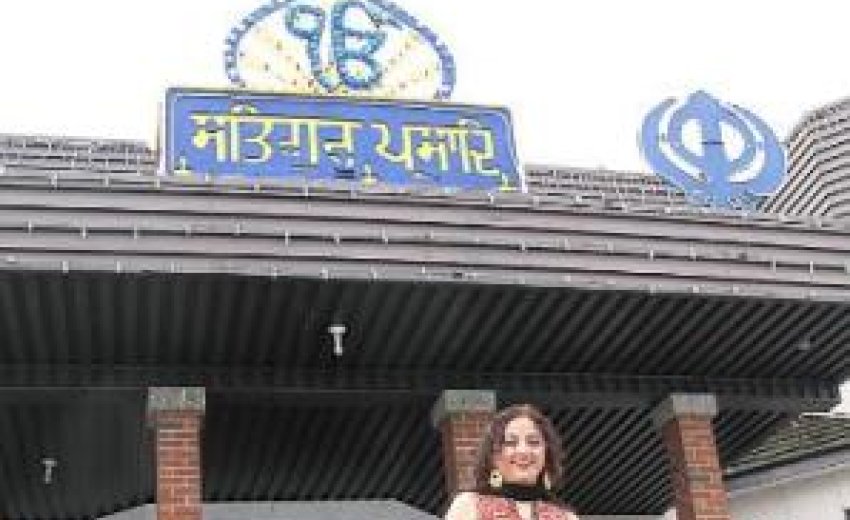 |
| Harpal Dhillon at the Guru Nanak Sikh Temple in Vernon. Sikhism is the fifth-largest organized religion in the world, with more than 25 million adherents, and is steadily growing. Cara Brady/Morning Star |
The traditional Sikh temple has doors on all sides indicating that God is everywhere and that everyone is welcome.
Sikhism had its beginnings in northern Punjab in the late 15th century. The founder, Guru Nanak Dev Ji, troubled by the religious conflict he saw around him, developed and taught three fundamental principles: Naam Jaapna — remembering God through prayer and meditation; Kirat Karo — earning an honest living; and Vand Chaako — selflessly serving others by sharing income and resources.
Sikhs strive to live a life that balances work, worship and charity. Community is emphasized and the gurdwara (temple) is the centre of Sikh communal life. The traditions and philosophy of Sikhs were established by 10 specific gurus until 1708.
The basic belief is that God is common to all and that there must be tolerance and absolute equality of all people without regard to gender, race, caste or religion.
About 150 local Sikh families worship at the Guru Nanak Temple, opened in 1987 by the North Okanagan Sikh Cultural Society.
While many Sikhs go to the temple daily, the biggest meeting is on Sundays with worship led by Sher Singh, the granthi (priest) who has recently come to Vernon. There are prayers, music and readings followed by a communal meal. With the emphasis on charity, larger temples serve meals available to the entire community daily while the Vernon temple serves open meals on Sundays. The meal is of great significance as it symbolizes the importance of equality and service in the community. The final service of each day ends with prayers and the invocation to God (Ardaas), which prays for the universal blessing and well- being of all mankind.
There are no ordained holy days as each moment is considered holy, and living itself is considered an act of devotion. The main celebrations are the birthdays of Guru Gobind Singh, Guru Nanak Dev Ji, and Vaisakhi, usually April 13 or 14 each year, with readings from Adi Granth, the holy book, 24-hours a day for three days with people taking turns reading for two hours each to read the entire book.
Harpal Dhillon, a member of the North Okanagan Sikh Cultural Society, explained some of the traditional clothing and symbols and what these mean to Sikhs.
“The turban is so that Sikhs can recognize each other from far away and go to each other for help if needed,” she said. Women may also choose to wear a turban, a statement of identity and commitment to the faith and service to humanity, as men and women are equal in the Sikh faith.
“Baptized Sikhs — men, women, and children — have five distinctive symbols of purity and courage: uncut hair, a wooden comb, a metal bracelet, a specific type of undergarment and a strapped, curved sword. The sword must only be used for protection as a last resort for oneself or another who needs help.”
Baptized men are given the surname Singh (lion) as a reminder to be courageous and women are given the surname Kaur (princess) to emphasize dignity.
“Women are equal. We are all human so how can you say man is higher or woman is lower? Women give birth to all the prophets, gurus and kings. God is one. We have different paths to go but we respect all people whoever you are,” said Dhillon, who came to Canada from India in 1978. She and her husband, Jasbir, have four children. “My faith tells me who I am. I can’t imagine life without my belief.”
She is pleased to be part of the Inter-Faith Bridging project which brings people of different faiths together.
“I am learning so much. If we can ask questions of each other respectfully, we can learn and talk and avoid conflict of any kind. So many people don’t ask questions because we are afraid to ask but it is better if we can talk and learn about other cultures and religions.”

